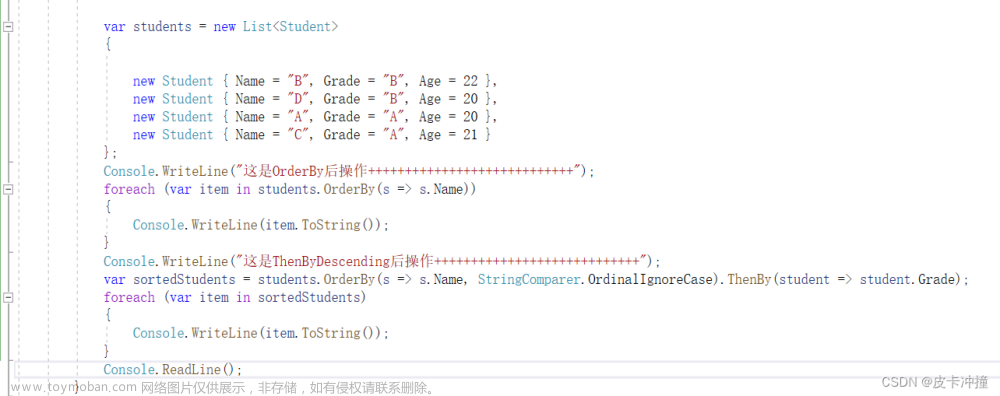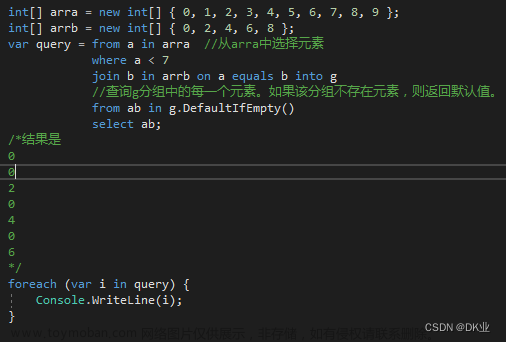在.net Core 5 WebAPI 项目中应用 EF Core 5 实体框架,使用Linq的Contact联合进行多表查询。
定义两个子查询语句,查询结果 select 返回的对象结构类型都是一致的。
var query1 = from auth in Context.Authentications
where auth.Status == 1
select new ComplainInfo
{
UserId = auth.UserId,
Reason = auth.Reason,
ReplyContent = "",
ReplyTime = (DateTime?)null
};
var query2 = from complaint in Context.DatingComplaints
where complaint.Status = 1
select new ComplainInfo
{
UserId = complaint.UserId,
Reason = complaint.Reason,
ReplyContent = complaint.ReplyContent,
ReplyTime = complaint.ReplyTime
};
//联合两个子查询
var query = query1.Contact(query2);
var items = await query.ToListAsync();Linq查询结果集封装对象类:
public class ComplainInfo
{
public long UserId { get; set; }
public string Reason { get; set; }
public string ReplyContent { get; set; }
public DateTime? ReplyTime { get; set; }
}DatingComplaint 实体类映射(Fluent API):
public class DatingComplaint
{
public long Id { get; set; }
public long UserId { get; set; }
public string Reason { get; set; }
public string ReplyContent { get; set; }
public DateTime? ReplyTime { get; set; }
}
public class DatingComplaintEntity : IEntityTypeConfiguration<DatingComplaint>
{
public void Configure(EntityTypeBuilder<DatingComplaint> builder)
{
builder
.ToTable("DatingComplaint")
.HasKey(o => o.Id);
builder
.Property(o => o.Id)
.UseHiLo("DatingComplaintId")
.IsRequired();
builder
.Property(o => o.UserId)
.IsRequired();
builder
.Property(o => o.Reason)
.HasMaxLength(1000)
.IsRequired();
builder
.Property(o => o.ReplyContent)
.HasMaxLength(1000)
.IsRequired(false);
builder
.Property(o => o.ReplyTime)
.IsRequired(false);
}
}但在执行到 ToListAsync() 代码行查询返回结果时,抛出以下错误:
Unable to translate set operation when matching columns on both sides have different store types
经检查发现,query1 子查询中的 Replycontent 与 query2 子查询中的 ReplyContent 匹配列具有不同的存储类型,导致无法进行 union 集合查询操作。
从 DatingComplaint 实体类定义中可以看到,ReplyContent 属性同样使用 string 类型来定义, 与 Linq 查询结果集封装对象 ComplainInfo 中的 ReplyContent 属性都是使用 string 类型定义。若是从对象属性类型来看,很难判断出具有不同的存储类型的问题所在。
进行一步分析,既然是类型(string)一致,会不会字符串类型的长度不一致,导致进行 union 集合查询时 EF 认为是不同的存储类型?
实体类定义的 ReplyContent 属性映射的是可变室长的字符串类型(即:nvarchar(1000)),而类对象中的string类型 EF.core 会解析成最大长度的字符串类型(即: nvarchar(max))进行查询。
此时执行Linq查询时,就会产生匹配到列具有不同的存储类型的异常。
解决方案:
既然找到了是匹配列具有不同的存储类型的原因,将子查询语句中的列统一转换成相同类型再进行查询。
query1 查询语句中的 ReplyContent 非实体映射返回的属性值,EF.Core 解析生成列类型为 nvarchar(max)。可以将 query2 查询语句中 ReplyContent 实体映射返回的属性值类型(nvarchar(1000)),转换成 nvarchar(max)。
可以使用 Convert.ToString() 方法进行转换处理。
var query2 = from complaint in Context.DatingComplaints
where complaint.Status = 1
select new ComplainInfo
{
UserId = complainUser.Id,
Reason = complaint.Reason,
ReplyContent = Convert.ToString(complaint.ReplyContent),
ReplyTime = complaint.ReplyTime
};执行Linq查询语句生成的SQL语句可以看到 对 ReplyContent 列进行了 nvarchar(max) 类型的转换,如下:文章来源:https://www.toymoban.com/news/detail-536780.html
SELECT [a].[UserId], [a].[Reason], N'' AS [ReplyContent], NULL AS [ReplyTime]
FROM [Authentication] AS [a]
WHERE ([a].[Status] = 1)
UNION ALL
SELECT [d].[UserId], [d].[Reason], CONVERT(nvarchar(max), [d].[ReplyContent]) AS [ReplyContent], [d].[ReplyTime]
FROM [DatingComplaint] AS [d]
WHERE [d].[Status] = 1注:若两个实体对象使用相同属性类型(string)但字符串长度不一致时,也可以使用类型转换方式来处理。文章来源地址https://www.toymoban.com/news/detail-536780.html
到了这里,关于EF.Core 使用Linq的Contact联合查询问题的文章就介绍完了。如果您还想了解更多内容,请在右上角搜索TOY模板网以前的文章或继续浏览下面的相关文章,希望大家以后多多支持TOY模板网!










